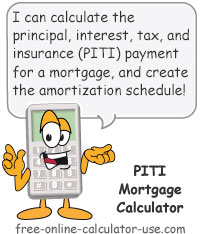IMPORTANT: Numeric entry fields must not contain dollar signs, percent signs, commas, spaces, etc. (only digits 0-9 and decimal points are allowed).
Click the Terms tab above for a more detailed description of each entry.
Step #1:
Enter the price of the home.
Step #2:
Enter the down payment amount. If you would like the calculator to calculate the down payment from a percentage, be sure you have entered the home price, then tap the "+" icon to reveal the down payment percentage calculator.
Step #3:
Enter the mortgage's annual interest rate.
Step #4:
Enter the number of years you will be financing the home for.
Step #5:
Enter the estimated annual real estate taxes. If you would like the calculator to calculate the real estate taxes from a percentage, be sure you have entered the home price, then tap the "+" icon to reveal the real estate taxes percentage calculator.
Step #6:
Enter the estimated annual homeowner insurance premium. If you would like the calculator to calculate the annual insurance premium from a percentage, be sure you have entered the home price, then tap the "+" icon to reveal the insurance premium percentage calculator.
Step #7:
If you want to discover how many hours you will need to allocate to working to make all of the PITI and PMI payments, enter your Real Hourly Wage here.
Step #8:
Indicate whether or not you want the calculator to include a monthly or annual amortization schedule, or none at all.
Step #9:
Click the "Calculate PITI Mtg Pmt" button. This will display the mortgage amount, the LTV ratio, and the interest cost, plus populate the PITI breakdown chart.



Follow me on any of the social media sites below and be among the first to get a sneak peek at the newest and coolest calculators that are being added or updated each month.